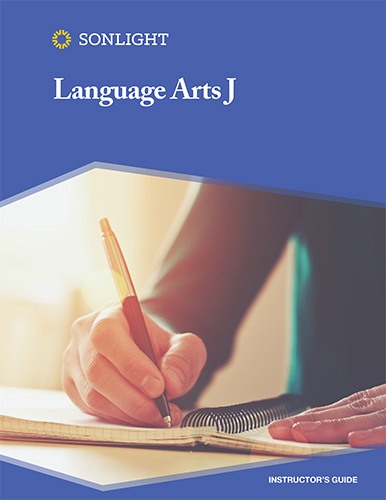Sonlight Language Arts J covers literature, grammar, composition, and vocabulary using real books, dictation, creative written expression, and discussion. The course is recommended for students in grades eight through ten, although it seems best for eighth or ninth graders because of both the literature selections and the fact that it serves as a literature-survey type course.
Sixteen novels are used along with the Language Arts J Instructor’s Guide. Among the novels are The Thief, The Gammage Cup, Treasure Island, Mrs. Frisby and the Rats of NIMH, A Christmas Carol, and The Phantom Tollbooth. It’s a diverse and interesting collection of literary works. You can purchase the novels as part of a complete package, but if you plan ahead and request books from the library, you should be able to borrow many of them.
The instructor’s guide has four sections and comes as loose-leaf pages with pre-punched holes for you to insert into your own binder. The first section explains how to use the course—critical information for parents to read since it explains the unusual methodology.
The second section presents weekly lesson plans with detailed instructions for each day. Student activity sheets at the end of each week’s lesson plans are to be removed and given to students to complete. (If you are teaching more than one student or reuse the course, you will need to order additional sets of student activity pages.) Student activity pages integrate instruction with exercises and assignments, so parents need not explain each activity.
The third section of the instructor’s guide, Reading Assignments and Notes, provides detailed notes for the novels with a brief overview of each book and its setting, vocabulary words with definitions, cultural literacy terms and their meanings, and discussion questions. Discussion questions are primarily at the comprehension level, although they occasionally challenge students’ critical thinking skills.
The fourth section has aids for both teacher and student. For the teacher, there is a scope and sequence for the course plus tips on how to teach writing and use rubrics to evaluate written work. For students, there are instructions on how to do literary analysis, an extensive grammar guide, and guides for writing a position paper and a research paper.
Students do writing assignments every week, working on a wide range of composition styles through the year. They write narratives, a memoir, a travel guide, a response paper, literary analyses (from different angles with different assignments), various types of essays (including timed essays), character sketches, descriptive writing, newspaper articles, interviews, and either a research project or a radio broadcast script.
Although students should be able to work through most of the course independently, a parent or teacher needs to present dictation passages for students to write, lead discussions as students read one or more chapters from the novels, and guide students through writing projects as needed. Student activity pages clearly direct students when they need to interact with a parent. Answers to exercises on the activity pages are in the instructor’s guide.
Many of the lesson activities draw on passages from the literature. Material from the novels is used for dictation passages, many of the examples for grammar and mechanics instruction, and some models for composition skills. While lesson activities in grammar, vocabulary, and composition have a high degree of integration with the assigned literature, some activities are not integrated. For example, students choose their own topic for a persuasive essay in week 16, and in a two-week writing project to create their own newspaper or magazine, the instructor’s guide tells students, “You can set it at the current time or in the time and setting of Jekyll and Hyde,” giving them freedom to connect with the literary work or not. Even with this integration, parents are still free to adjust the reading schedule to fit each student, even skipping books if necessary.
Parents will need to become familiar with the methodology of the course: the use of dictation, monitoring spelling and grammar errors in written work, using rubrics to evaluate work, leading discussions, and teaching vocabulary within your discussion of each novel. This requires more parental involvement than traditional courses with predictable answers. So while students can read and complete much work on their own, parents still need to be very involved.
While many of the literary works offer opportunities to explore character and the human condition, I was surprised to find no Christian content in the course.
Note that the literature component (the third section of the instructor’s guide) is identical to the corresponding section for readers in Sonlight’s History of Science J (History, Bible, and Literature course). While Language Arts J can stand alone, it was designed to dovetail with History of Science J, and the novels are all included in the complete package for History of Science J if you choose to use that course.
In summary, the course does an excellent job of teaching literature, composition, and vocabulary in an integrated fashion. Grammar is included, but it is taught more through application than exercises, which is appropriate for this level. If needed, parents can supplement with additional work in grammar and/or vocabulary using suggestions in the instructor’s guide.









